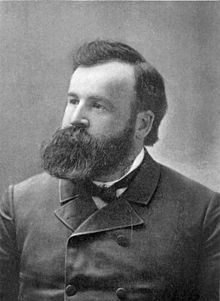William Hamilton Gibson
William Hamilton Gibson | |
|---|---|
 | |
| Born | October 5, 1850 |
| Died | July 16, 1896 (aged 45) Washington, Connecticut |
| Nationality | American |
| Known for | drawings |
| Scientific career | |
| Fields | Natural history |
| Author abbrev. (botany) | W.H.Gibson |
| Signature | |
William Hamilton Gibson (October 5, 1850 – July 16, 1896) was an American illustrator, author and naturalist.
Biography
Gibson was born in
He rapidly became an expert illustrator and a remarkably able wood-engraver, while he also drew on stone with great success. He drew for The American Agriculturist, Hearth and Home, and Appletons
He died of
Works
Gibson illustrated S. A. Drake's In the Heart of the White Mountains, C. D. Warner's New South, and E. P. Roe's Nature's Serial Story; and his own books, The Complete American Trapper (1876; revised, 1880, as Camp Life in the Woods); Pastoral Days: or, Memories of a New England Year (1880); Highways and Byways (1882); Happy Hunting Grounds (1886); Strolls by Starlight and Sunshine (1890); Sharp Eyes: a Rambler's Calendar (1891); Our Edible Mushrooms and Toadstools (1895); Eye Spy: Afield with Nature among Flowers and Animate Things (1897); and My Studio Neighbours (1898).[3]
References
- ^ Adams, John Coleman (1901). William Hamilton Gibson: Artist—Naturalist—Author. New York: G. P. Putnam's Sons.
- ^ a b c Johnson, Rossiter; Brown, John Howard, eds. (1906). The Twentieth Century Biographical Dictionary of Notable Americans. Vol. IV. Boston: American Biographical Society. Retrieved March 28, 2022 – via Internet Archive.
- ^ a b c Chisholm 1911, p. 944.
- ^ International Plant Names Index. W.H.Gibson.
Attribution:
- This article incorporates text from a publication now in the public domain: Chisholm, Hugh, ed. (1911). "Gibson, William Hamilton". Encyclopædia Britannica. Vol. 11 (11th ed.). Cambridge University Press. p. 944.
